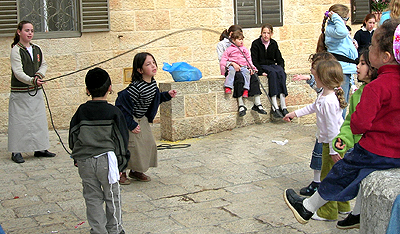|
Street Rhymes are created by children usually in game playing, counting, and entertainment. Games are an important aspect of child development, including role identification and socialization. "Through.. games, in addition to having fun and getting exercise, they learn leadership and cooperation, rules (and rule evasion), physical skills, and social roles" (Mergan). As part of these games, rhymes and rhythms were created to accompany actions (as in jumprope and hopscotch), form rules ( "IT" games) or announce the end of a game (Ollie ollie oxen free). Some games, such as jacks or marbles, often played with ankle bones of small farm animals, occurred simultaneously in widespread areas, including Europe, Asia and pre-Columbian Americas and New Zealand (Mergan), showing the nature of children and child's play as universal. The rhymes that stemmed from these games can range from single lines to long complex narratives, depending on the application to the game. Perhaps the most important element of these poems is the rhythm structure, which is designed to establish cadence, in many cases, an important part of a particular activity, such as handclapping games and rope jumping.
Mergen, Bernard. "Street Games." Encyclopedia of Children and Childhood in History and Society. Ed. Paula S. Fass. Vol. 3. New York: Macmillan Reference USA, 2004. 791-794. 3 vols. Gale Virtual Reference Library. Thomson Gale. Citrus College. 29 Aug. 2006 Saltman, Judith. "Trade and Plumbcake Forever". The Riverside Anthology of Children's Literature, 6th ed. Houghton Mifflin, 1985. © T. T. Eiland, August, 2006 |
